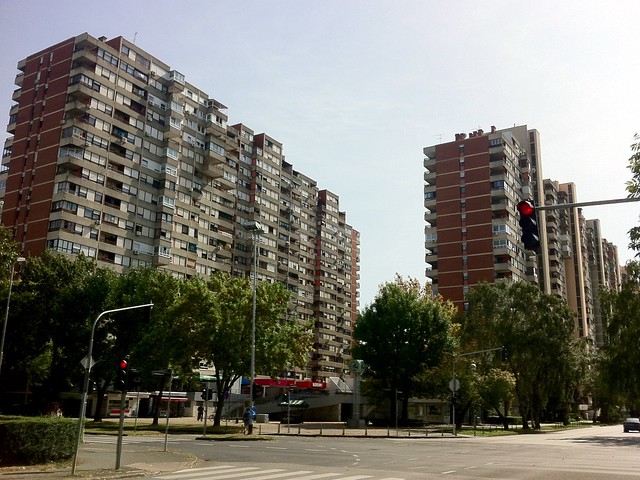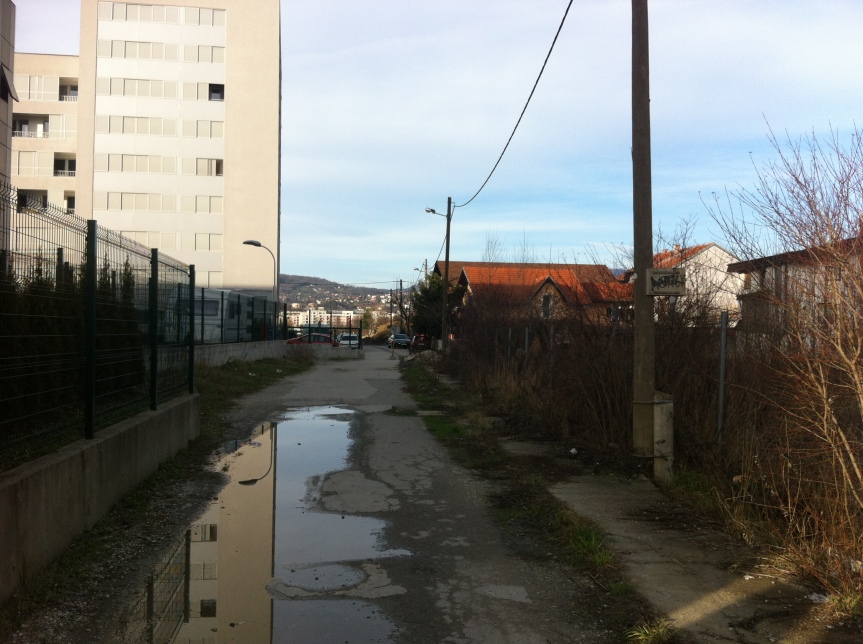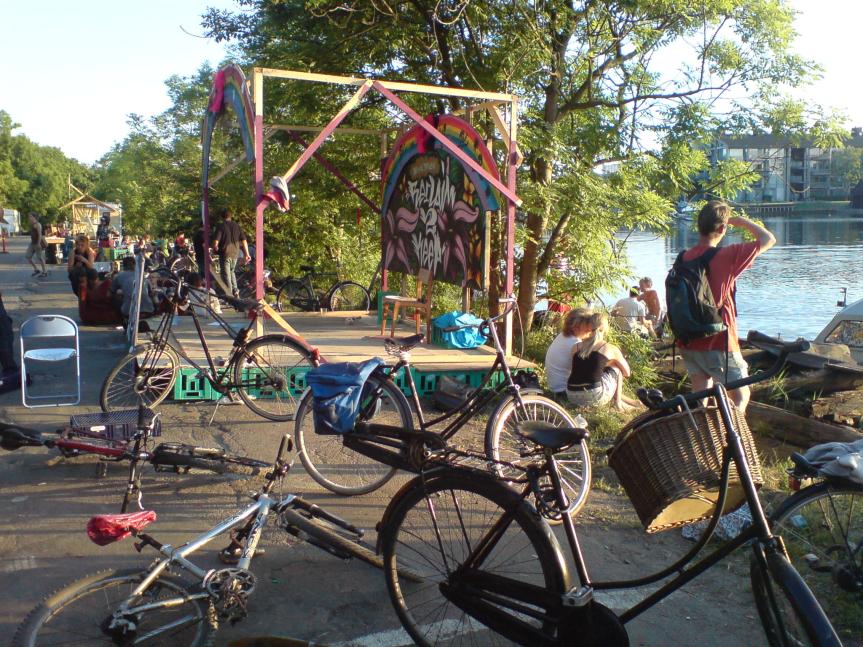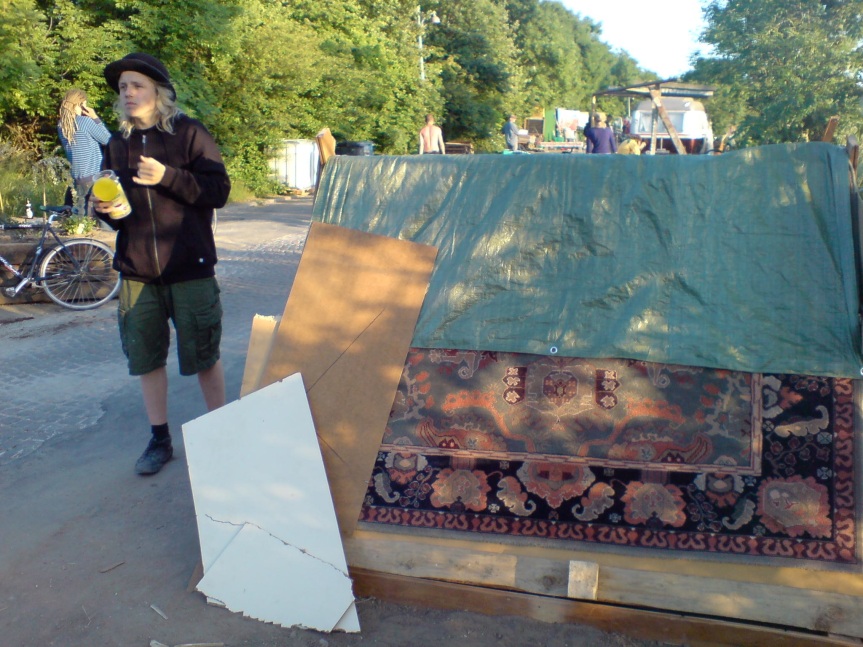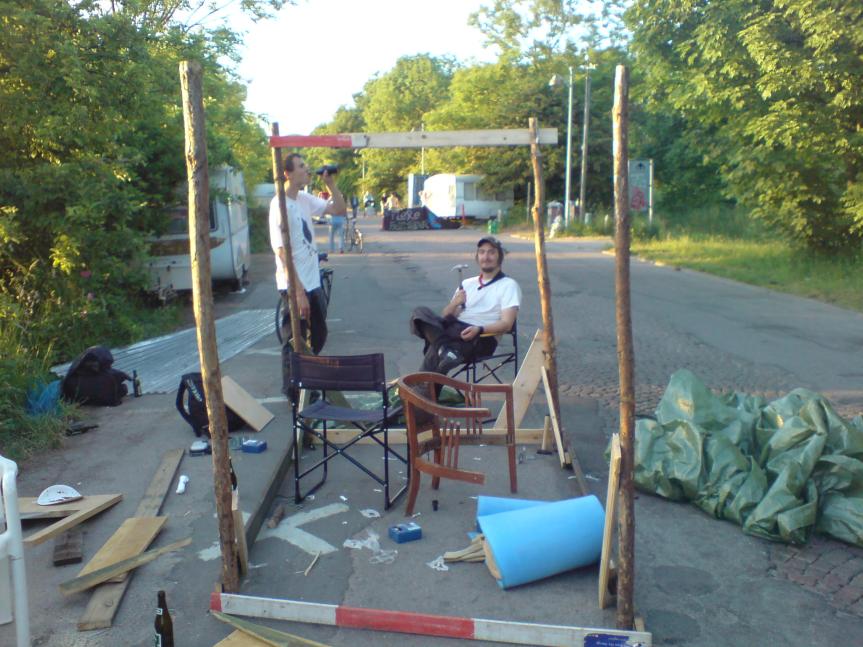I always wanted to explore Novi Zagreb and the other day the chance was there to wander around for a couple of hours. Novi Zagreb is like New Belgrade a massive new urban development that in both cases is connected to the old center of town with bridges across the river Sava. (See the book on Lefebvre and the project on New Belgrade he was involved in here)
Tag: Appropriation
Wild west of Zagreb
Took a walk in the western suburbs of Zagreb where the Industrial and the Informal city meets in a sharp contrast. The walk was just about 1000 meters but it felt like worlds apart. From an area that could be called “Cities for People” (thanks to Jan Gehl) via “Cities by People (that I enjoy) to the “City of greed”.
In the “City of Greed” the same (profit maximising) industrial logic applies to both the businesses, the shopping centre and the housing. ” The City for people” is a good example of very well functioning and popular housing from the Yugoslav times, (but when I saw it first time I thought it was the ugliest place on earth).
The “City by People” is where the self build houses tell stories about who are living there and how the houses and the neighbourhood has been created over time. It is a place where the unpredictable beauty in an aesthetic sense is present along with the strong sense of the other kind of beauty that relates to the creation and use of these houses.
See more Photos on Flickr here
Opbyggerne – Urban Innovation in Copenhagen
One of the things that I would envy my son was an experience some years ago where he and hundreds of other people in Copenhagen started building on a beautiful spot close to Christiania. The initiative was taken by a group of activists who called themselves “Opbyggerne” – a play with words that both means those who build up or those who are constructive in a conversation. The action was really joyful, spontaneous and open where everybody was welcome – as a passerby buying a drink or listening to music, or those who would take part in discussions and eat in the improvised street kitchen. But off course the main point was to build something together.
“Opbyggerne” had picked an otherwise impossible narrow strip of land along a road that went past Christiania (and a part of the old Copenhagen Ramparts) on one side and on the edge of the canals that surrounds other old army facilities that now are turned into expensive housing (as a stark contrast to Christiania – also being an old army base but with a different and urban life). The lazy ones would build on land either on the road or on the edge of the water. The more ambitious ones would build floating constructions that would inhabit the water. Materials were either found, supplied by sponsors or in the case of my son found on Christiania.
After passing the place one day he decided to go for it with he’s friends the following weekend. On the same day they managed to get materials (plywood on Christiania), build a very small tent-like house and sleep there (three boys) for the night. Very basic but so fundamental for the way we could work with a city and let it become a place for concrete and fun creation. Where each building is an expression of the dreams and needs of very different people and how these change over time. In this case The tent-like structure became too small for the boys so they started adding on to it and made it possible to sit in the new construction also letting in more light. Now it was possible to have visitors.
The whole place became a hectic and creative melting pot of desires and the possibility to realise these within a day or a week. At times these desires also worked against each other and heated discussions or more constructive dialogue made this experiment an example on how you can build a city and discuss the way it works in the same movement. It is a way of expressing yourselves in a much more concrete way that is based on action instead of abstraction (talking, writing, drawing etc). The concrete act of building structures as an expression of your desires (and capability of building) makes it possible for people who might not care about sitting down and talk but rather do it – the building then becomes a part of a discussion.
It makes the urban dialogue more inclusive and it makes the sensory and emotional experience of the city much richer. And all of that also adds to the interaction between people helping and inspiring each other, and setting off ideas for other projects and initiatives. This potential for urban innovation has to be seen in the perspective of the beautifully designed public squares of the “Urban Renaissance” and the talk about the chance encounter in these public spaces. In many cases these very controlled and often market dominated spaces (often the success criteria is that there are a lot of people there drinking cafe latte) are the opposite of “Opbyggerne.” In the urge for beauty, these spaces becomes architectural monuments, unable to be appropriated, but predictable and popular with the interests that wants to make money there – not that far from the shopping centre: “a mall without walls.”
The potential for “urban innovation” could be exemplified with the goal of “unplanned collaboration” of Pixar, the computer animated movies studio behind movies like “Finding Nemo” og “Wall-e”. Their first success was created in the typical surroundings of a start up company: run down buildings in an unattractive area that made the rent cheap but maybe more importantly the building(s) were possible to appropriate and if you wanted a hole in the wall thats what you just made. So it had many possibilities for spontaneous and improvised appropriation of that space and when the company needed to get everybody “under one roof” to avoid the fragmentation that came from sitting in many separate localities they build with the goal of “unplanned collaboration.” The result doesn’t look fancy from the outside and inside it has the aesthetics of a classic factory building with a large common space as the equivalent of a “public space” that can de changed into what the situation takes – the fun company gathering or building large scale mockups of movie sets. More important is probably how they kept the possibility of appropriating the personal workspaces and in that way the personal space becomes an expression of what you like and who you are. To free the full urban potential one have to move from the less ambitious goal of chance encounters to the much more dynamic goal of “unplanned collaboration”.
Many cities has embraced the idea of “creativity” as a way of staying on top in the competition with other cities in the new globalised race. The main inspiration for this was the book of Richard Florida that promoted the 3 T´s: Tolerance, Technique and Talent. One of the main references in the book and the following implementation of he’s ideas was San Francisco and it is interesting how Pixar probably couldn’t have started anywhere else than in that city. The problem now is that municipalities set up zones for creative industries – like digital games etc both defining what is creative and where it should/could happen. It is almost as uncreative as if the wanted more new companies like Apple to start by building suburban garages and looking for collage dropouts (and orphans) to populate these.
The reaction to the miniature “summer of love” next to Christiania that the “Opbyggerne” created was very telling. It was tolerated by the municipality during the summer (apart from some intimidating policing) but when summer was over the area was evicted in a way that didn’t leave a single trace of what had happened. They even cleaned the road of graffiti and made the place look more like it used to be than before. Going there was like entering a time machine where it all seemed a bit unreal, knowing was used to be there.
Instead “creativity” has been allocated to zones with old industrial buildings or in ghettos where they in one case try to emulate the meatpacking district of New York. The municipality has succeeded to some degree in the sense that entering one of the local bars, where designs and pricing of the drinks are done by famous artists, made you feel like being a part of an episode of “Sex and the City.” What happened here and what is the problem with this particular perception of the “creative” is that the slow and unavoidable gentrifying process in a place like the meatpacking district has been cut down to zero making this creative ghetto to an instantly controlled and gentrified public space that does not have much potential of urban innovation or “unplanned collaboration.” You have to look for somebody else and elsewhere for that. Where you can feel free to start building something together in many different ways.
See more photos here
Urban Oeuvre and/or an architectonic Masterpiece?
 Why is it, that when people travel to see new cities they typically pick (old) areas that are diverse and rich in both a sensory and emotional sense – (and the mainstream tourism that profit on these places is also the one that gradually destroy that richness). Newly build areas are seldom attractive in a way that would make people go there the but singular buildings (monuments) are. Probably the best example is the Sidney opera house by Jorn Utzon. Is the problem that we build cities today the same way as we build monuments like the opera house?
Why is it, that when people travel to see new cities they typically pick (old) areas that are diverse and rich in both a sensory and emotional sense – (and the mainstream tourism that profit on these places is also the one that gradually destroy that richness). Newly build areas are seldom attractive in a way that would make people go there the but singular buildings (monuments) are. Probably the best example is the Sidney opera house by Jorn Utzon. Is the problem that we build cities today the same way as we build monuments like the opera house?
I think that Utzon is a true genius when it comes to his more singular or monumental buildings and I often refer to the way he was building and designing in the same mo(ve)ment when he build he’s last house on Mallorca. He would notice that certain pillars or walls already build needed to be different and he would ask the builders to move this or rebuild that – always paying the builders a little extra (bottles of wine). For me this is a good example on how the process of building a house becomes much less static and finite and thus allows for change and improvisations. Utzon was always very close to nature and most of his references go to natural phenomena or more monumental buildings like the Maya temples. But he did build two housing projects in Denmark that refers to more urban situations in Arab villages or the secret city of Beijing. They are praised as an architectural “pearls” but they also point to the problem when such building projects is developed and perceived as one singular and finite piece of architecture.
The problem with the Arab og Chinese references are that they are taken as a snapshot in time that overlooks that the area/village has grown over time and would continue to do that if nothing else happens. The spatial character of such spaces is a product of the people living there and gradually transforming these spaces over time. In this sense the space becomes both a physical space that can be measured and photographed but most importantly is an almost living and organic expression of the people who have inhabited that space and in that also pointing to the openness to possible for future adaptations. In that sense these “living” structures becomes “natural” in an urban sense and could have been an inspiration for Utzon just as the clouds or the plants were. His own last house on Mallorca show some of that more organic and open process of how buildings can be build.
It is interesting to see how the buildings that Corbusier designed in Pessac outside of Bordeaux gradually got decorated or people compensated for problems in the design such as the flat roofs (also inspired by Arab villages). In both a wish to make the houses look more personal and in a functional sense the design of Corbusier was being appropriated in what could be called a “natural” urban process that would be in accordance to the arab references. In contrast to the buildings of Corbusier – being very stringent and based on precise, inflexible proportions – Utzons organic layout of the Kingo houses are closer to the Arab references and could have been appropriated without going against the architecture like in the case of the Pessac buildings. But here the finite “architectural” oevre and the fact that the buildings were owned by a building associations meant that appropriations were either forbidden or maybe the law abiding Danes were just not up for challenging the design of Utzon, who shortly after the houses were build, became famous by winning the competition for the opera house in Sidney.
 One place not far from the Kingo houses, some not very law abiding Danes have either build their own houses or appropriated the existing army barracks on Christiania in Copenhagen. This is probably one of the few examples in the world where the above mentioned stream of tourists choose to go to a (in parts) newly build area. All houses are build or appropriated over time as a result of a local culture that tries to live less conventional and they are therefore all different. Christiania have just celebrated 40 years of existence and people keep building, renewing, adding on to the existing buildings there. Hopefully that process will keep going and serve as an inspiration for the more mainstream way of life and inspire the way we think of creating a less finite and open – urban – view on how to continuously build the city while we are discussing how it should be. What is more important than the amount of tourists that will visit such a place is that the very concrete/physical expression of the continuous creation of a city points to the fact that it is possible to take part in a way that makes people dream of a better future and inspires to take action.
One place not far from the Kingo houses, some not very law abiding Danes have either build their own houses or appropriated the existing army barracks on Christiania in Copenhagen. This is probably one of the few examples in the world where the above mentioned stream of tourists choose to go to a (in parts) newly build area. All houses are build or appropriated over time as a result of a local culture that tries to live less conventional and they are therefore all different. Christiania have just celebrated 40 years of existence and people keep building, renewing, adding on to the existing buildings there. Hopefully that process will keep going and serve as an inspiration for the more mainstream way of life and inspire the way we think of creating a less finite and open – urban – view on how to continuously build the city while we are discussing how it should be. What is more important than the amount of tourists that will visit such a place is that the very concrete/physical expression of the continuous creation of a city points to the fact that it is possible to take part in a way that makes people dream of a better future and inspires to take action.
